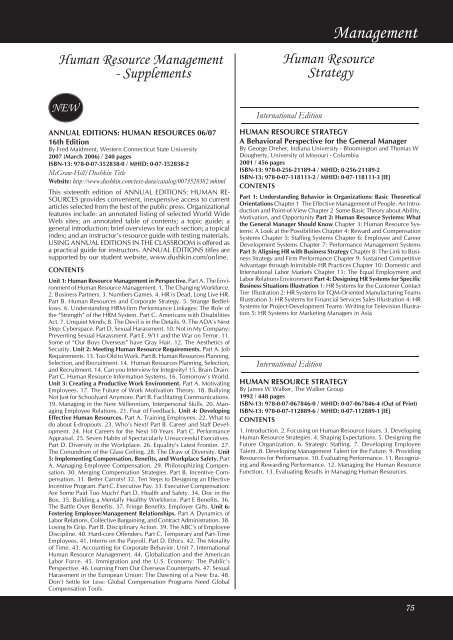Business Communication - McGraw-Hill Books
Business Communication - McGraw-Hill Books
Business Communication - McGraw-Hill Books
Create successful ePaper yourself
Turn your PDF publications into a flip-book with our unique Google optimized e-Paper software.
Human Resource Management- SupplementsHuman ResourceStrategyManagementNEWANNUAL EDITIONS: HUMAN RESOURCES 06/0716th EditionBy Fred Maidment, Western Connecticut State University2007 (March 2006) / 240 pagesISBN-13: 978-0-07-352838-0 / MHID: 0-07-352838-2<strong>McGraw</strong>-<strong>Hill</strong>/Dushkin TitleWebsite: http://www.dushkin.com/text-data/catalog/0073528382.mhtmlThis sixteenth edition of ANNUAL EDITIONS: HUMAN RE-SOURCES provides convenient, inexpensive access to currentarticles selected from the best of the public press. Organizationalfeatures include: an annotated listing of selected World WideWeb sites; an annotated table of contents; a topic guide; ageneral introduction; brief overviews for each section; a topicalindex; and an instructor’s resource guide with testing materials.USING ANNUAL EDITIONS IN THE CLASSROOM is offered asa practical guide for instructors. ANNUAL EDITIONS titles aresupported by our student website, www.dushkin.com/online.CONTENTSUnit 1: Human Resource Management in Perspective. Part A. The Environmentof Human Resource Management. 1. The Changing Workforce.2. <strong>Business</strong> Partners. 3. Numbers Games. 4. HR is Dead, Long Live HR.Part B. Human Resources and Corporate Strategy. 5. Strange Bedfellows.6. Understanding HRM-firm Performance Linkages: The Role ofthe “Strength” of the HRM System. Part C. Americans with DisabilitiesAct. 7. Unquiet Minds. 8. The Devil is in the Details. 9. The ADA’s NextStep: Cyberspace. Part D. Sexual Harassment. 10. Not in My Company:Preventing Sexual Harassment. Part E. 9/11 and the War on Terror. 11.Some of “Our Boys Overseas” have Gray Hair. 12. The Aesthetics ofSecurity. Unit 2: Meeting Human Resource Requirements. Part A. JobRequirements. 13. Too Old to Work. Part B. Human Resources Planning,Selection, and Recruitment. 14. Human Resources Planning, Selection,and Recruitment. 14. Can you Interview for Integreity? 15. Brain Drain.Part C. Human Resource Information Systems. 16. Tomorrow’s World.Unit 3: Creating a Productive Work Environment. Part A. MotivatingEmployees. 17. The Future of Work Motivation Theory. 18. BullyingNot Just for Schoolyard Anymore. Part B. Facilitating <strong>Communication</strong>s.19. Managing in the New Millennium, Interpersonal Skills. 20. ManagingEmployee Relations. 21. Fear of Feedback. Unit 4: DevelopingEffective Human Resources. Part A. Training Employees. 22. What todo about E-dropouts. 23. Who’s Next? Part B. Career and Staff Development.24. Hot Careers for the Next 10 Years. Part C. PerformanceAppraisal. 25. Seven Habits of Spectacularly Unsuccessful Executives.Part D. Diversity in the Workplace. 26. Equality’s Latest Frontier. 27.The Conundrum of the Glass Ceiling. 28. The Draw of Diversity. Unit5: Implementing Compensation, Benefits, and Workplace Safety. PartA. Managing Employee Compensation. 29. Philosophizing Compensation.30. Merging Compensation Strategies. Part B. Incentive Compensation.31. Better Carrots? 32. Ten Steps to Designing an EffectiveIncentive Program. Part C. Executive Pay. 33. Executive Compensation:Are Some Paid Too Much? Part D. Health and Safety. 34. Doc in theBox. 35. Building a Mentally Healthy Workforce. Part E Benefits. 36.The Battle Over Benefits. 37. Fringe Benefits: Employer Gifts. Unit 6:Fostering Employee/Management Relationships. Part A Dynamics ofLabor Relations, Collective Bargaining, and Contract Administration. 38.Losing Its Grip. Part B. Disciplinary Action. 39. The ABC’s of EmployeeDiscipline. 40. Hard-core Offenders. Part C. Temporary and Part-TimeEmployees. 41. Interns on the Payroll. Part D. Ethics. 42. The Moralityof Time. 43. Accounting for Corporate Behavior. Unit 7. InternationalHuman Resource Management. 44. Globalization and the AmericanLabor Force. 45. Immigration and the U.S. Economy: The Public’sPerspective. 46. Learning From Our Overseas Counterparts. 47. SexualHarassment in the European Union: The Dawning of a New Era. 48.Don’t Settle for Less: Global Compensation Programs Need GlobalCompensation Tools.International EditionHUMAN RESOURCE STRATEGYA Behavioral Perspective for the General ManagerBy George Dreher, Indiana University - Bloomington and Thomas WDougherty, University of Missouri - Columbia2001 / 456 pagesISBN-13: 978-0-256-21189-4 / MHID: 0-256-21189-2ISBN-13: 978-0-07-118111-2 / MHID: 0-07-118111-3 [IE]CONTENTSPart 1: Understanding Behavior in Organizations: Basic TheoreticalOrientations Chapter 1 The Effective Management of People: An Introductionand Point-of-View Chapter 2 Some Basic Theory about Ability,Motivation, and Opportunity Part 2: Human Resource Systems: Whatthe General Manager Should Know Chapter 3: Human Resource Systems:A Look at the Possibilities Chapter 4: Reward and CompensationSystems Chapter 5: Staffing Systems Chapter 6: Employee and CareerDevelopment Systems Chapter 7: Performance Management SystemsPart 3: Aligning HR with <strong>Business</strong> Strategy Chapter 8: The Link to <strong>Business</strong>Strategy and Firm Performance Chapter 9: Sustained CompetitiveAdvantage through Inimitable HR Practices Chapter 10: Domestic andInternational Labor Markets Chapter 11: The Equal Employment andLabor Relations Environment Part 4: Designing HR Systems for Specific<strong>Business</strong> Situations Illustration 1: HR Systems for the Customer ContactTier Illustration 2: HR Systems for TQM-Oriented Manufacturing TeamsIllustration 3: HR Systems for Financial Services Sales Illustration 4: HRSystems for Project-Development Teams: Writing for Television Illustration5: HR Systems for Marketing Managers in AsiaInternational EditionHUMAN RESOURCE STRATEGYBy James W Walker, The Walker Group1992 / 448 pagesISBN-13: 978-0-07-067846-0 / MHID: 0-07-067846-4 (Out of Print)ISBN-13: 978-0-07-112889-6 / MHID: 0-07-112889-1 [IE]CONTENTS1. Introduction. 2. Focusing on Human Resource Issues. 3. DevelopingHuman Resource Strategies. 4. Shaping Expectations. 5. Designing theFuture Organization. 6. Strategic Staffing. 7. Developing EmployeeTalent. 8. Developing Management Talent for the Future. 9. ProvidingResources for Performance. 10. Evaluating Performance. 11. Recognizingand Rewarding Performance. 12. Managing the Human ResourceFunction. 13. Evaluating Results in Managing Human Resources.75HED 2007 Management.indd 7510/5/2006 1:24:19 PM

















